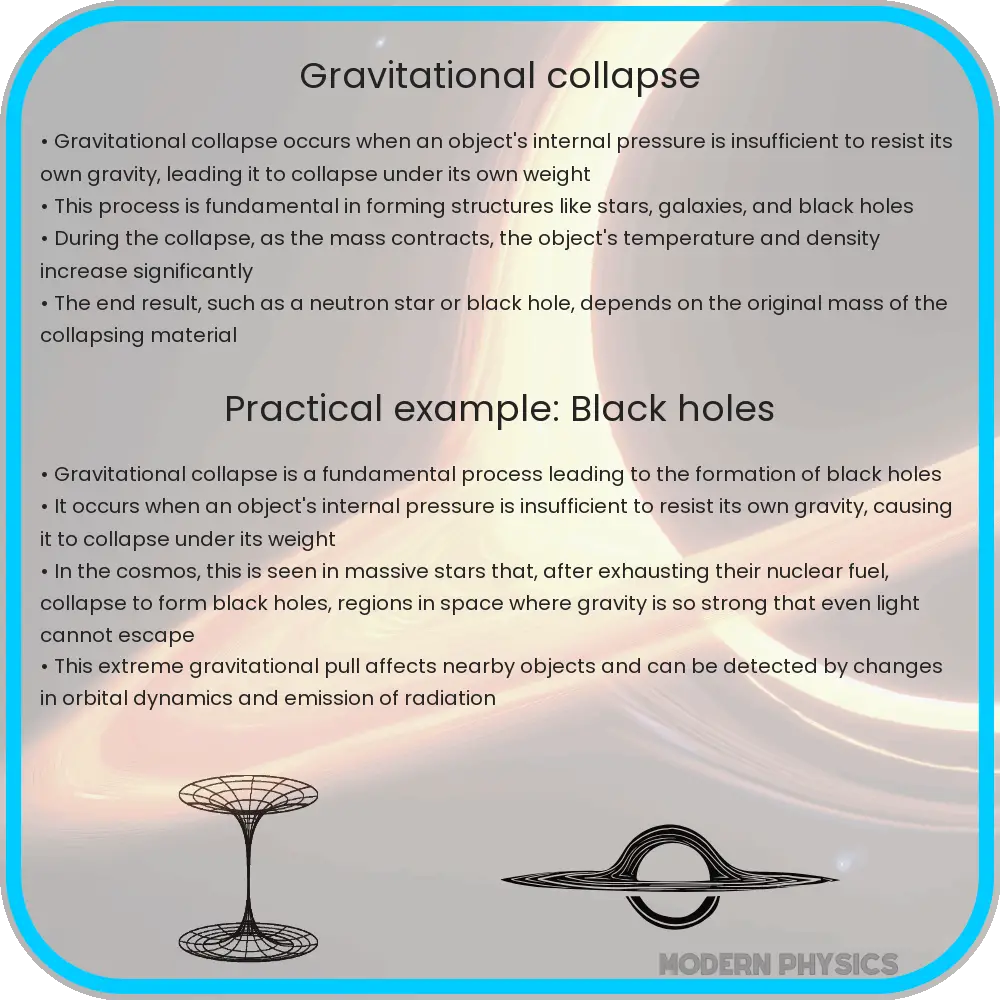Explore the mysteries of the universe with our article on gravitational collapse, event horizons, singularities, and space-time in astrophysics.

Understanding Gravitational Collapse in Astrophysics
Gravitational collapse is a fundamental process in astrophysics that leads to the formation of various astronomical structures, including stars, galaxies, and black holes. This phenomenon occurs when a massive object’s internal pressure is insufficient to counterbalance its gravitational pull, causing it to collapse under its own weight.
Event Horizon: The Point of No Return
The concept of the event horizon is crucial in the study of black holes, which are an extreme outcome of gravitational collapse. An event horizon represents a boundary in space-time beyond which events cannot affect an outside observer. In simpler terms, it’s the point around a black hole where the gravitational pull becomes so intense that not even light can escape. This boundary delineates the visible universe from the mysterious interiors of a black hole.
The Mysterious Singularity
At the heart of a black hole lies the singularity, a point where matter is thought to be infinitely dense and the laws of physics as we understand them cease to apply. In a singularity, space and time are believed to have infinite curvature, a concept that challenges our understanding of the universe. Theories suggest that at this point, all the mass of the black hole is concentrated, leading to an infinite gravitational pull.
Space-Time and Gravitational Collapse
Space-time, a four-dimensional construct that combines the three dimensions of space with the dimension of time, plays a critical role in understanding gravitational collapse. In the theory of general relativity proposed by Albert Einstein, gravity is not a force but a curvature of space-time caused by mass. When a massive object like a star collapses, it significantly warps the fabric of space-time, leading to phenomena such as black holes and the associated event horizons and singularities.
Gravitational collapse not only leads to the formation of black holes but also initiates the birth of stars. In stellar nurseries or nebulae, clouds of gas and dust undergo gravitational collapse, leading to the formation of protostars. These protostars eventually ignite nuclear fusion reactions in their cores, marking the birth of a star.
This process highlights the dynamic and ever-evolving nature of the cosmos, where gravitational forces constantly shape and reshape the structure of the universe.
The Role of Gravitational Collapse in Galaxy Formation
Gravitational collapse is not only crucial in star and black hole formation but also plays a pivotal role in the formation of galaxies. Galaxies, massive systems of stars, interstellar gas, dust, and dark matter, are believed to form through the gravitational attraction of smaller protogalactic clouds. These clouds, under the influence of gravity, merge and grow over time, eventually leading to the large and complex structures we observe as galaxies today.
Implications for Cosmology and Astrophysics
The study of gravitational collapse has far-reaching implications in cosmology and astrophysics. It helps astronomers understand the lifecycle of stars, the formation of galaxies, and the nature of black holes. Moreover, investigating these phenomena provides insights into the behavior of matter and energy under extreme conditions, testing the limits of our physical theories.
Advancements in observational technology, such as powerful telescopes and gravitational wave detectors, have opened new windows into studying these cosmic events. The detection of gravitational waves, for instance, has provided direct evidence of the existence and mergers of black holes, validating predictions made by the theory of general relativity.
Challenges and Future Directions
Despite significant progress, numerous challenges remain in fully understanding gravitational collapse. The singularity at the center of black holes, for example, represents a breakdown of current physical theories. This has led to ongoing efforts to reconcile general relativity with quantum mechanics, aiming to develop a theory of quantum gravity.
Future research endeavors are also focused on observing and understanding the earliest stages of star and galaxy formation, which are crucial for understanding the evolution of the universe. The James Webb Space Telescope, among other instruments, is expected to provide unprecedented insights into these early cosmic epochs.
Conclusion
Gravitational collapse, a fundamental mechanism in astrophysics, plays a pivotal role in shaping the universe. From the formation of stars and galaxies to the enigmatic nature of black holes, it underpins many of the most significant phenomena in the cosmos. While considerable progress has been made in understanding these processes, the mysteries of gravitational collapse continue to challenge and inspire scientists, driving forward the frontiers of knowledge in astrophysics and cosmology. As we continue to observe and explore the vastness of space, gravitational collapse remains a key concept in unraveling the complexities of the universe.
